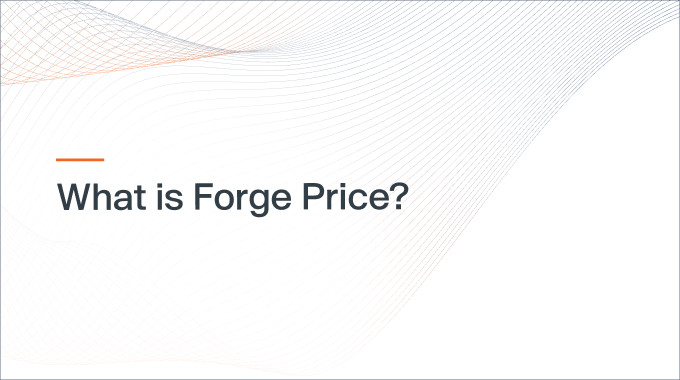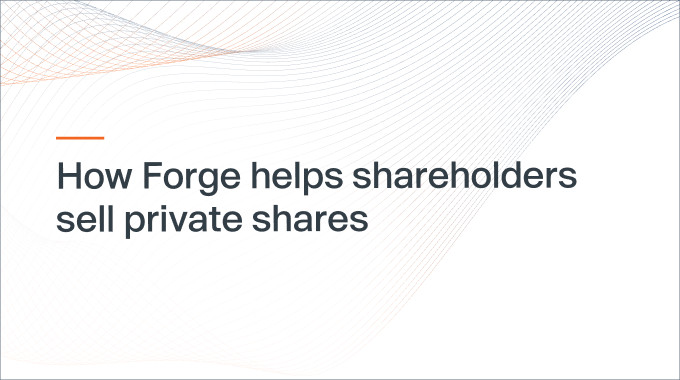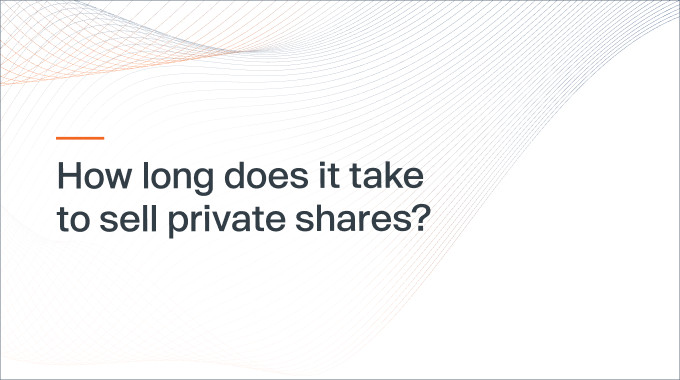Highest bid, lowest ask, last matched and Forge Price: Understanding private share pricing signals
In the public market, prices are transparent, trade volume is typically high and transactions occur in real time. In the private market, by contrast, price discovery is more opaque and reliant on less frequent, less standardized data points. For investors and shareholders looking to trade private company shares, understanding the different pricing signals available—particularly those available to users on the Forge platform—is helpful for making informed decisions.
This guide explores four of the most important private market pricing signals: highest bid, lowest ask, last matched and Forge Price™. It also outlines additional indicators investors can consider to form a more complete view of share values.
How order books work: Understanding bids, asks and market spread
Just like public exchanges, private trading platforms like Forge operate with an order book that aggregates current bids (offers to buy) and asks (offers to sell). While transaction volume in the private market is typically lower, this structure still plays a fundamental role in shaping pricing dynamics. Here are two key definitions in this paradigm:
- Highest bid: The maximum price a buyer is willing to pay.
- Lowest ask: The minimum price a seller is willing to accept.
The difference between the two is known as the bid-ask spread. A narrow spread typically indicates a more active market, with buyer and seller expectations closely aligned. A wider spread can potentially signal price uncertainty, valuation gaps or lower liquidity opportunity.
On the Forge platform, buyers can offer non-binding bids to purchase and sellers can place asks to sell. These bids and asks help populate what constitutes the “active market” of private companies listed on Forge marketplace. This provides visibility into market appetite for shares—even when no recent trades have occurred.
The active market doesn’t just indicate current interest—it also sets the stage for price discovery. When the highest bid meets the lowest ask, a transaction can occur, and that matched price becomes a critical reference point.
Last matched: The most recent trade
- Last match: The last matched price is the most recent transaction price at which a buyer and seller successfully completed a trade of shares on the Forge platform.
- What it signals: This price reflects the most recent market-clearing level—the price at which demand and supply aligned for that company’s shares.
- Caveats: Because private shares don’t trade as frequently as public shares, the last matched price can become stale. It may not reflect current investor sentiment, especially if there have been major developments—like new funding rounds, leadership changes or regulatory events—since the last trade.
Still, last matched prices remain a useful reference point for gauging historical demand, anchoring price discussions and contextualizing the spread between active bids and asks.
Forge Price: A proprietary daily indicator of share value
In response to the need for more standardized pricing in the private market, Forge developed Forge Price.
More specifically, Forge Price is a derived, indicative price, calculated daily for hundreds of pre-IPO venture-backed late-stage companies—it synthesizes data from various sources, including secondary market transactions, recent funding rounds and bids/asks on the Forge platform.
- What it signals: Forge Price offers a comprehensive, historic view of share value by synthesizing disparate data points into a single reference metric. It is not tied to a single transaction, which makes it particularly useful when trades are infrequent.
- Why it matters: For investors, brokers and shareholders, Forge Price can serve as a market-informed benchmark. It’s particularly valuable in cases where:
- There have been no recent trades, but meaningful buy/sell interest exists.
- Price signals from comparable companies or public markets are ambiguous.
- Institutional investors need a third-party data point to inform fair market value assessments.
You can view a company’s Forge Price on company profile pages alongside active order book data, last matched prices and other relevant metrics.
Other pricing indicators to consider
While Forge Price and last matched transactions offer vital insights, a more extensive pricing analysis in the private market can sometimes summon a broader perspective. Here are additional data sources and indicators that can inform valuations:
1. Public and private company comparables
Valuation multiples (such as price-to-revenue or price-to-earnings) from comparable public companies can be used as benchmarks to estimate fair value in the private market. Similarly, private company funding rounds or disclosed valuations can offer peer-based context—though direct comparisons require careful normalization for growth, risk and liquidity differences.
2. Fund marks
Funds that hold private company shares are required to disclose their internal fair value estimates—often quarterly. These marks reflect institutional perspectives on the company’s current value, which can be especially telling if multiple large investors converge on a similar estimate. While lagging by nature, these marks still serve as a valuable triangulation point.
3. News and market sentiment
Announcements about product launches, earnings milestones, layoffs or IPO plans have the potential to dramatically shift perception and share pricing. Staying informed about relevant news is critical to understanding what may drive pricing interest (or disinterest) in a company’s shares.
4. Leadership and company governance changes
Executive transitions—such as a founder departure, new management or a board reshuffle—can potentially impact investor confidence and change the perceived value of a company. In the absence of daily trading volume, these leadership developments may influence future pricing more than current matched trades suggest.
5. Other Factors
- Macroeconomic environment: Broader market conditions—like rising interest rates or a downturn in the tech sector—can affect demand for private company shares.
- Liquidity preference: The presence (or absence) of institutional buyers, who typically seek preferred stock that has liquidity preference over common stock, seeking exposure to private companies in specific sectors (i.e. the artificial intelligence sector) can shape pricing.
- Lockup periods and transfer restrictions: Limitations on when or how shares can be traded may also impact price discovery and investor willingness to engage.
Building a helpful private share pricing mosaic
There’s no single “right price” in the private market—only a collection of informed signals that must be interpreted holistically. By understanding the nuances behind highest bid, lowest ask, last matched and Forge Price, investors gain a clearer picture of where a company’s shares stand in terms of current market sentiment and value.
When combined with other broader indicators, these pricing metrics help create a more complete picture—empowering buyers and sellers to make better-informed decisions in a market where transparency has traditionally been limited.
Forge offers the tools, data and expertise needed to navigate this evolving landscape. To view the active market, track Forge Price and access trading opportunities in hundreds of leading private companies.



